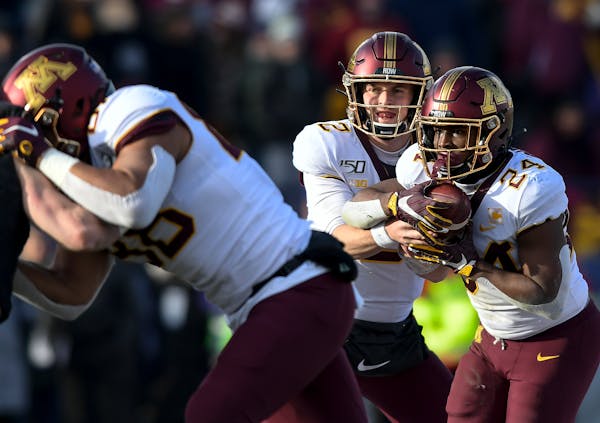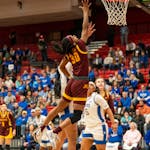 See
more of the story
See
more of the story
Ohio State did not join the same conference as Minnesota until 1912. It was called the Big Nine, although one of the original members, Michigan, was in the midst of being tossed out (1907-16) for failure to adhere to league rules.
It was a long train ride from Minneapolis to Columbus, Ohio, and the Gophers and the Buckeyes rarely scheduled one another.
They played five times before World War II, with the Gophers winning three, including 13-7 at Ohio Stadium in 1940 on coach Bernie Bierman's way to 8-0 and a vote as national champions.
The Gophers repeated the 8-0 (not playing the Buckeyes) in 1941 and were voted as national champions for the fifth time in the Bierman Era.
Bernie had served as a Marine in World War I and he went back into the service as a 48-year-old. He coached Iowa Preflight in 1942. As the Big War wound down, he returned to coach the Gophers in 1945.
Ohio State was in the midst of a three-game winning streak (1944-46) vs. the Gophers. The teams played next on Oct. 15, 1949, in Columbus.
This was the fourth season of an agreement in which the Big Nine would send a representative to the Rose Bowl to play the winner of the Pacific Coast Conference.
The Gophers were loaded with outstanding talent, several of whom were war veterans. They were 3-0 and rated No. 5 in the country when taking on the No. 11 Buckeyes.
Final: Gophers, 27-0.
Sid Hartman always said that Rose Bowl fever erupted from our prairie farmlands to the Canadian border.
Bud Grant, an outstanding end for those Gophers, said Tuesday: "We played very well against a highly rated team, in its stadium. It was one of the best college games I played in, but what happened after that … it takes away from that.''
The Gophers would be back on the train to play Michigan in Ann Arbor the next week. The Gophers had moved up to No. 3 in the rankings, and Michigan was No. 12.
"I learned a lot of lessons playing college football of what to do as a coach, and lessons on what not to do,'' Grant said. "We were getting a lot of praise after the Ohio State game, and Bernie didn't want us to get big heads. So he scrimmaged us hard that week before we left for Michigan.
"We weren't as good against Michigan and lost a close game (13-7), and then we practiced hard again, and lost at home to Purdue. We really played poorly in that game.''
Lesson A for Grant, a Hall of Fame coach in both the Canadian Football League and the NFL with the Vikings: Don't wear out your team on the practice field.
Lesson B was don't hire close friends as assistant coaches. In Bud's view, Bernie did that, made some lineup decisions based on favoritism rather than ability, and wound up keeping Verne Gagne on the bench way too often.
"Verne could've been one of the best linemen in college football,'' Grant said. "He didn't play nearly enough.''
The 27-0 rout of Ohio State was Bierman's last great victory. He was fired after going 1-7-1 in 1950. That included a 48-0 beating from the Buckeyes in Minneapolis.
Running back Vic Janowicz was the Heisman Trophy winner for the Buckeyes. They were rated No. 1 in the country with two weeks left, then lost to Illinois and Michigan.
Wes Fesler quit at Ohio State and then was hired to replace Bierman at Minnesota. Fesler had the Heisman Trophy runner-up in Paul Giel (a close second to Notre Dame's Johnny Lattner) in 1953, went 4-4-1 and also quit at Minnesota.
And get this: The schedule back then included playing six or seven conference opponents, and the Gophers and Ohio State didn't play from 1950 to 1965.
Things have been a bit rocky for our fellas since more frequent meetings started to occur. Since '65, the Gophers are 3-39 vs. Ohio State, going into Thursday night's game here when they are merely 14-point underdogs.
This "merely'' is used with full sincerity, because the point spread for a half-century often has been three touchdowns or more in the Buckeyes' favor.
OK, but digest this:
1. Ohio State lost its top four linebackers, and killer linebackers have been the Buckeyes' defensive trademark for quite some time. They have prospects as replacements.
2. The Gophers have a huge, veteran offensive line that includes two early-round NFL draftees-in-waiting, Daniel Faalele and Blaise Andries, to go with a relentless, All-America running back in Mohamed Ibrahim.
A modern version of the Woody Hayes' playbook: "Four yards and a swath of turf.''
The Buckeyes' defense can be kept on the field. James Laurinaitis isn't showing up to do anything about it.
And when and if the upset of the Buckeyes does come, Minnesota, don't immediately start jabbering about the Rose Bowl (or CFP, 2021).
I still remember my father Richard, elite Gophers fanatic, lamenting years later: "That '49 team was the best ever. That shoulda been our first Rose Bowl.''







